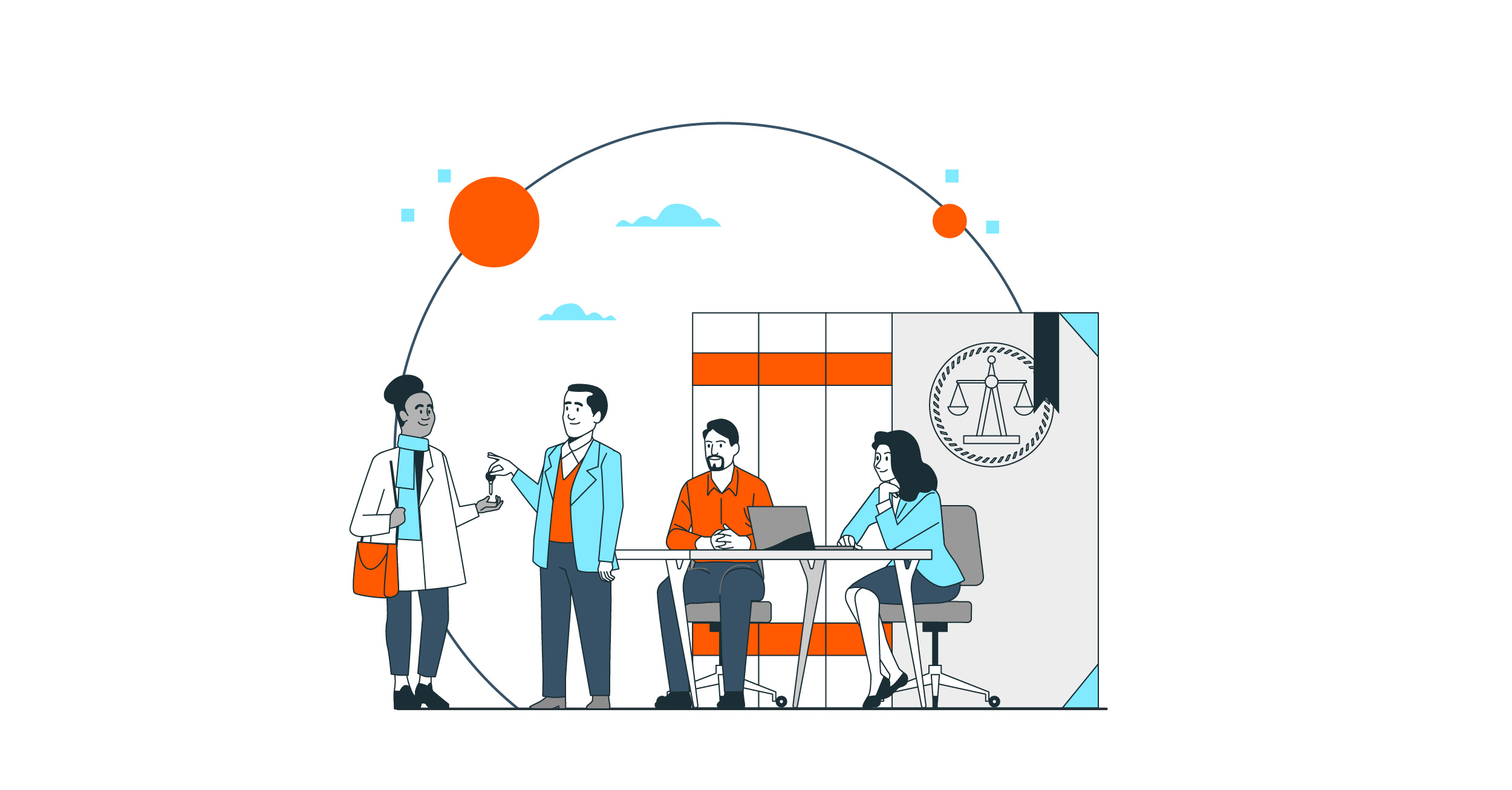
Highlights:
-
Damp and mould put tenants' health at risk and could seriously damage your property.
-
Landlords can keep their tenants and properties safe through regular inspections and proactively resolving the causes of damp and mould.
-
If a tenant reports a problem with damp and mould, landlords need to respond as a priority.
-
Damp is essentially moisture. If parts of your rented property are exposed to dampness for too long, it will experience mould growth.
-
Mould releases toxins that can cause respiratory issues and other health problems.
-
There are three types of damp issues: rising damp, penetrating damp, and condensation.
-
Rising damp and penetrating damp are the landlord’s responsibility.
-
Condensation is less clear. Tenants and landlords both have a role to play in preventing it.

In 2020, two-year-old Awaab Ishak died from a respiratory disease after living in mouldy conditions at his family’s housing association flat.
The tragedy put damp and mould in rental accommodation into the spotlight, with government and regulators pledging to do more to get landlords to deal with damp and mould in their rented properties.
Yet according to research by Citizens Advice, 2.7 million privately rented households are living with damp, mould or excessive cold. It says this figure includes 1.6 million children.
Damp and mould shouldn’t be an issue in any property. Not only is the health of tenants at risk, but also the property itself could be seriously damaged.
Landlords can keep their tenants and properties safe through regular inspections and proactively fixing the causes of damp and mould.
If a tenant reports a problem with damp and mould, landlords need to respond as a priority.
This article explains everything you need to know about managing damp and mould in your rental property.
What Is Damp and Mould?
Damp is essentially excess moisture. If parts of your property are exposed to dampness for too long, they will experience mould growth.
Mould is when fungus starts to grow on something. Fungus thrives in warm, wet conditions, like a damp home.
There are three main types of damp:
Rising damp
Rising damp occurs when moisture enters the building fabric from the ground. The building soaks the moisture up like a sponge and makes its way through tiny external wall gaps.
Penetrating damp
Penetrating damp is when water enters the building fabric via a leak inside or outside the property. It could be caused by a dripping tap or missing roof slates.
Condensation
This is the most common form of moisture in homes. It is caused when warm air meets a cold surface, or when there are high humidity levels.
Common causes of condensation include:
-
Excessive showering and bathing
-
Cooking and boiling water
-
Drying laundry
Condensation can be reduced by improving insulation and ventilation. Examples of how to do this include:
-
Ensuring the loft has 300 mm of insulation
-
Fitting double-glazed windows with trickle vents
-
Fitting extractor fans in bathrooms and kitchens
-
Adding vents to improve airflow
It can also be reduced by ensuring a room is ventilated when releasing moisture into the air. For example, if you are drying clothes in a room, opening a window will reduce condensation.
The Dangers of Living with Damp and Mould
Mould releases spores which contain toxins that can cause respiratory issues - especially if you are asthmatic, have a lung condition, or have a weakened immune system.
It can cause many unpleasant illnesses, from headaches to skin rashes and even a fever or bronchitis.
Children are particularly at risk from health issues caused by mould; as we have already seen, these can be fatal.
When Is Mould the Landlord's Responsibility?
Landlords are responsible for issues relating to the building itself. This means that rising damp and penetrating damp are almost always the landlord’s responsibility.
If mould affects your tenant’s health or stops them from using some rooms, you should investigate and fix the problem urgently.
A better approach is to perform regular inspections and proactively deal with issues that could eventually create rising damp or penetrating damp. For example, some of the pipes in the bathroom may be old and rusty. If you spot this, you can plan to replace them before they leak.
When Is Mould the Tenant's Responsibility?
Mould is the tenant’s responsibility if their home:
🏠 Does not have damp
🏠 Is adequately insulated
🏠 Has adequate ventilation
🏠 Has a fully operational heating system
🏠 Doesn’t have any structural problems
🏠 Doesnt have some form of water leak or ingress
If this is the case, it may be that the resident is not using the heating or ventilation properly, which could be causing condensation, which in turn is causing mould to develop.
The problem with condensation is that it can be difficult to tell what the root cause of the problem is.
This has led to poor practices in the past, with some unscrupulous landlords blaming damp and mould problems on tenants’ lifestyles and refusing to fix them.
However, this usually worsens the problem. You will upset your tenant and the condensation will eventually damage your property.
A good approach is to:
-
Make sure your property definitely doesn’t have damp - for example, carry out a damp survey.
-
Make sure your property is definitely well-heated, insulated and ventilated.
-
Explain to tenants how they can reduce condensation levels in their home.
Damp and Mould Legislation
Several pieces of legislation and regulations govern landlord responsibilities regarding damp and mould. They are:
-
Under the Homes (Fitness for Human Habitation) Act 2018, landlords are responsible for keeping properties suitable for human habitation. Part of that means ensuring that living in a property won’t make tenants sick.
-
The Deregulation Act 2015 says that landlords have to respond to complaints about damp, mould, or condensation within a reasonable timeframe, as well as investigate and fix them if necessary.
-
The Housing Health and Safety Rating System is used by environmental health officers to assess hazards in residential housing. Damp and mould are considered mandatory repairs under the Housing Health and Safety Rating System, meaning landlords must carry them out quickly and correctly.
What happens if landlords don’t take action?
You cannot and should not ignore a damp problem or your tenant’s requests to investigate or fix the issue. There are many reasons why:
-
It could harm your tenant’s health.
-
The local authority could order you to fix the mould if it is a health hazard.
-
Your tenant could claim compensation.
-
Your property could be damaged.
Even if you think the cause of the problem is the tenant, it’s often better to deal with the problem yourself to keep them happy, avoid legal action, and keep your property in good condition.
Usually, you should only ask the tenant to deal with an issue if they have been consistently negligent.
6 Steps for Dealing with Damp and Mould
-
Respond
If your tenant reports damp or mould to you, you have 14 days to respond in writing, telling them how and when you will deal with the problem.
-
Assess the situation
Ideally, you’ll investigate the problem yourself or have a tradesperson look at it.
Initially, try to find out:
-
The severity of the situation.
-
What repairs are required?
-
Has your tenant’s health been affected?
-
Is there any damage to the building or the tenant’s possessions?
-
Has any previous work been done to try and fix the problem?
-
Identify the cause
Common causes of damp and mould include:
-
Leaking pipes
-
Faulty heating systems
-
Missing roof tiles and guttering
-
Cracked exterior walls and rotten window frames
If you can’t see the cause then you could have rising damp. This could be because your property doesn’t have a damp proof course. Alternatively, you might need a new damp proof course because the existing one is damaged.
-
Consider hiring a professional
If the cause of the problem is relatively obvious or the extent of the damp or mould is limited then you can usually manage it yourself.
But if the cause isn’t obvious or there is a lot of damp and mould, you may wish to hire a specialist like this company.
-
Repair the damage
Repair or replace anything that has been damaged. This could include plaster, skirting boards or flooring. You also need to redecorate the affected room.
-
Fix the root cause
As mentioned earlier, damp could be caused by a wider issue. Make sure you fix these root causes or make improvements to the property that deals with them, otherwise they are likely to come back again.
Tips to Prevent Damp and Mould
Photo by Dương Nhân: https://www.pexels.com/photo/white-bed-linen-near-brown-wooden-window-frame-4389917/
One of the best ways to deal with damp and mould is for you and your tenant to understand what causes it and avoid it altogether.
Tips for tenants:
Talk to your tenant about condensation, damp and mould and give them these tips:
Heat your home correctly
One of the ways condensation is created is when warm air hits cold surfaces. This is why it builds up on windows during colder months. Tell your tenant to ensure that the temperature of their home is kept above 15/16 degrees. Explain that they may have to keep their heating on at a very low temperature all the time to achieve this.
Ventilate the property
This is probably the most important piece of advice for tenants. Make sure that they open windows or use extractor fans when doing things like:
-
Drying clothes
-
Cooking
-
Having a shower or bath
Tenants should also use lids when cooking with saucepans to avoid steam escaping, and try to dry washing outside if possible.
Make sure air can circulate
Avoid closing off areas of the house that could be prone to damp, mould, or condensation. For example, air out cupboards regularly and try to keep doors open during the day.
Use a dehumidifier
If your tenant has done all of the above and there is still condensation, you might consider providing them with a dehumidifier. This is a device that takes moisture out of the air and there is a range of different options available. This is particularly useful in the winter, when it may be too cold to ventilate the house adequately.
However, a dehumidifier won’t solve damp issues as the underlying problem won’t be fixed.
Tips for landlords
A landlord's role is more about ensuring that damp and mould don’t form in the first place. There are several damp solutions that you can try, including:
Carry out regular planned preventative maintenance
Planned preventive maintenance (PPM) is when a landlord takes a proactive approach to property inspection and repair. By inspecting your property annually and replacing or repairing things before they go wrong you can ensure that you spot damp and mould early, or better yet, stop it from happening altogether.
Some tenants fail to report leaks or serious damp and mould problems. In these situations you’ll still be responsible for ensuring the home is fit for human habitation, which is another reason why regular inspections are so important.
Fix leaks and faults immediately
The longer a leak is left, the worse the problem becomes. Don’t waste time when it comes to these repairs - deal with them as a priority.
Fit a damp-proof course
Fitting a damp-proof course (sometimes known as a damp-proof barrier) is the best way to avoid a rising damp problem in your property. Most newer properties will have one, but older homes often don’t.
It usually involves having a special damp-proof cream injected into the outer walls of the building just above the ground. This creates an impermeable barrier that stops moisture from entering the walls.
In some cases you may have to have a damp-proof membrane installed instead.
Installing damp-proof courses costs anything between £200 and £2,000 depending on your property and the supplier, so it’s worth doing some research and finding a good deal.
Use anti-mould products
Products such as anti-mould paint and damp sealant are useful for stopping damp coming through your internal walls, and can help to prevent mould from forming in the first place.
Install ventilation
There are several improvements you can make to ensure your property is well-ventilated. Examples include:
-
Fit trickle vents on windows
-
Install an extractor fan above the cooker and in the bathroom
-
Add an air vent to the loft hatch
-
Add air vents to the eaves in the loft
Install insulation
If you’ve added ventilation, then you may wish to add insulation too. This will ensure the property is a comfortable temperature for your tenants. It will also help avoid condensation forming.
Here are some insulation measures to consider:
-
Add loft insulation
-
Replace old windows and doors
-
Insulate your external walls
-
Add floor insulation
-
Use lagging on pipes and a jacket on your water tank
-
Add draught-proofing to doors and windows
Use damp and mould IoT devices
Today, landlords can get devices that they fit into residents’ homes to monitor environmental factors that indicate that damp and mould may occur.
They detect things like moisture in the air and temperature. This allows landlords to identify which of their properties are at risk of becoming mouldy.
These devices are particularly useful for housing associations, as it allows them to monitor damp and mould threats across their portfolio.
It also enables them to collect data on damp and mould. This helps them to better understand the causes of damp and mould, which allows them to make better decisions.
For example, they might find that properties that are kept at 17°C are rarely damp. They could then identify homes that are often colder than this and add extra insulation.
The benefits of such systems include:
-
Protect residents’ health and wellbeing
-
Identify and fix problems before they cause disrepair issues
-
Prioritise weekly remedial action
-
Understand the condition of your properties
💡EVO’s environmental monitoring |
|
Our customers have the option of fitting IoT devices in their properties. Our advanced but discreet, easy-to-install, and economical IoT devices continuously monitor environmental conditions and deliver early alerts for any potential heating, ventilation, damp or mould issues. |
Common Questions
Here’s some quick answers to common questions regarding damp and mould.
Is it the landlord's responsibility to get rid of mould?
Landlords are responsible for mould developing in a home if it is caused by:
💧Rising damp
💧Penetrating damp
💧Poor ventilation
💧Poor insulation
💧Water leak or ingress
Solving these problems may involve:
💡Repairing leaking pipes
💡Fixing cracks in the walls
💡Fitting extractor fans in bathrooms and kitchens
💡Ensuring the heating system works correctly
💡Making sure the roof is not leaking
Landlords are also responsible for fixing damage caused by damp and mould. This might include replastering or replacing rotten furniture.
Damp has a tendency to return. Landlords should re-inspect the property six weeks after repairs are completed.
Can I stop paying rent due to mould?
Residents do not have the right to withhold rent. If their landlord refuses to make repairs they should send the landlord a formal complaint. If no action is taken then they have several options:
💡Take the landlord to court under the Pre-Action Housing Disrepair Protocol.
💡Ask their local authority for the rented property to be inspected under the Housing Health and Safety Rating System (HHSRS).
💡If they are a social housing tenant they can complain to the Housing Ombudsman.
💡Make the repairs themselves and charge it back to the landlord.
If you and your resident are in a dispute over whose responsibility the mould is then you may wish to hire a third-party mediator.
Can I claim against my landlord for mould?
Residents can claim against their landlord for mould if:
✔️They have complained about it to the landlord already.
✔️The mould is created by a structural issue that the landlord has failed to address.
✔️The mould is becoming worse as a result of that structural problem.
Residents cannot take legal action against their landlord until they have sent a letter of claim. This should include:
✔️Details of the structural issue.
✔️When and how the landlord was informed.
✔️What the resident wants to see happen regarding repairs and compensation.
✔️Clearly states that the resident will take the landlord to court if the problem is not corrected within 20 days.
What is the guidance for landlords regarding damp and mould?
The UK government published guidance for landlords on understanding and addressing the health risks of damp and mould in the home.
It outlines:
✔️Legal standards
✔️How to identify and address damp and mould
✔️How to stop damp and mould from developing
✔️What resources are available to help you
How much compensation for mould and damp?
It depends on the severity of the problem and how long the landlord has failed to take action.
One council tenant in Salford was awarded £6,000 in compensation after ten years of putting up with a damp and leaky home. The landlord agreed to carry out repairs on the rented property six months after the resident sent a letter of claim to the landlord.
Prevent Damp and Mould in Your Properties with EVO
This article shows that prevention is better than cure when it comes to damp and mould.
One of the ways you can prevent it in your rented property is to use software like EVO to plan and carry out regular inspections and maintenance.
By transforming how maintenance, management, and repairs are delivered, EVO connects owners, residents, tradespeople, and property managers together to reduce costs and ensure transparency.
Our easy-to-use digital solution features:
-
Online dashboard: All your people, places, repairs, and service history all in one place, with a real-time calendar, messaging, and secure document storage.
-
Helpdesk: There to help with all repair and planned maintenance needs fast.
-
Repairs: Certified trades available 24 hours a day, ensuring a fast response and quality workmanship.
-
Reminders: Ensuring nothing falls through the cracks.
-
Service history: All jobs and services are logged and easily accessible, with completion notes and images.
-
Compliance: Gas safety compliance, electrical testing, and more, with digital records and service reports all in one place.
-
Emergency cover: Providing trustworthy 24/7 emergency services in case of serious issues.
Get in touch to learn how we can help you manage your inspection and repairs more effectively.
PHOTO BY EVO


